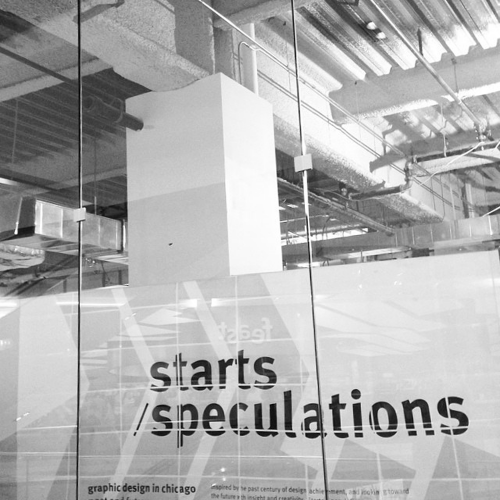
talking to tanner woodford about the chicago design museum.
We’re talking to Tanner Woodford, co-founder and executive director for the Chicago Design Museum. We’re in the new permanent space on Block Thirty Seven and a grand opening is less than a month away.
[DesignApplause] Tanner, this is the Chicago Design Museum’s third year? What’s different about this year?
[Tanner Woodford] Yes, it’s our third year and this year we’re becoming a permanent institution. The past two years we’ve been a pop-up. Our first year was in Humboldt Park and we had over 1,000 people attend our opening reception, which was an encouraging, pleasant surprise. Last year we moved to a more central location, here at Block Thirty Seven. We had 17,000 square feet. This year we have 5,000. At the Humboldt Park location, our visitors were mostly designers. But in Block Thirty Seven we are speaking to a more public audience. From walk-in traffic off the street, to the Blue Line station in this building. Building off the success of the last two years, we decided it was time to become permanent.
[DA] What have you learned in three years?
[TW] I have learned so much. In short, we are trying to institutionalize more.
[DA] What do you mean by institutionalize.
[TW] We’ve always learned by doing. For example, the color of this room. We wanted to go with a 2% grey instead of white, so that white objects pop and black is richer. So we painted the walls, tested it, and came away feeling it was little too cool. Our group decided to paint the walls again. We’ve begun to assess our curatorial processes. The museum’s business is curation—that’s our product. Now that we’re rooted in the community, we want to bring more traditional elements into our collections.
[DA] What kind of work are you looking for?
[TW] In the past we’ve only exhibited graphic design. Now we’re moving into the other disciplines of design: architecture, industrial design, fashion, interaction, and more. This is our first show in this space. We’re playing to our strengths, which is currently graphic design.
[DA] Mixing and matching is both interesting and stimulating. I recently interviewed fashion designer Elke Walter and she said she liked presenting her work in photo galleries and this week she’s in London in Zaha Hadid’s Design Gallery. And Luminaire, a furniture showroom, had a great fashion event. Tell us about the thrust of this event.
[TW] It’s called Starts / Speculation: Graphic Design in Chicago Past and Future. The idea is the gallery is divided in half. It’s non-linear and incomplete. Chicago is a city of broad shoulders, a very innovative community. We’re highlighting innovation over the last century. Starting with the Burnham Plan—urban planning—before moving through the New Bauhaus, Container Corporation and its Herbert Bayer-designed World Geographic Atlas. A lot of people don’t know that the CCA commissioned the recycle logo. We have the original Call to Entries for it. We’ve collected many interesting artifacts that signal the start of new things beginnings in Chicago. The other half of the gallery is forward-looking, consisting of local graphic design firms that answer the question ‘How will technology shape communication in 100 years?
[DA] And this is all Chicago.
[TW] This show is Chicago-focused, because it started as a celebration of the AIGA Centennial with the Chicago Chapter. The Chicago Chapter however wanted to celebrate 100 years of Chicago history rather than 100 years of AIGA history.
[DA] You talked to the AIGA (American Institute of Graphic Arts) and STA (Society of Typographic Arts) which are graphic design. Have you talked to other design disciplines like AIA, ASID and IDSA?
[TW] Chicago has a strong design community. I’ve talked to a few of those organizations. We have many community partners — Architecture for Humanity, for example – which is doing an event here on June 27 that coincides with the AIA national conference. We are trying to broaden our community partners.
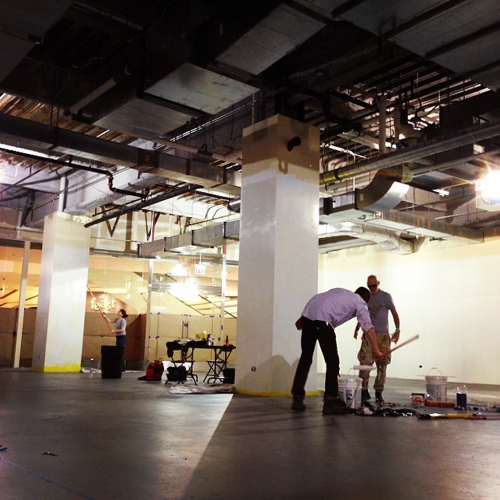
[DA] When there are exhibits here what’s the capacity?
[TW] 250 at one time, though we have a spillover space next door that accommodates several thousand.
[DA] How are you marketing yourself. You guys are very good at it.
[TW] We have an amazing marketing committee. We have two really great media sponsors, DesignApplause being one of them. We have four people on our marketing committee, and good press contacts. Frankly, now a lot of people are approaching us, asking what we are doing.
[DA] How many design museums are in the U.S.
[TW] There are over 100 cultural institutions in Chicago alone, including galleries and museums. At one time I was planning on visiting all of them, and that’s still on the bucket list.
In the states, I’ve been reaching out to a lot of directors of design museums. There’s Design Museum Boston and Design Museum Portland, which is under the same umbrella organization. There’s a Museum of Design in Atlanta. Of course there’s Cooper-Hewitt, the Walker, the Art Institute and the MCA, all of whom I have massive respect for.
Chicago is culturally rich and we’ve been lucky enough to find a niche here. We’re trying to complement what the city already has with regards to cultural resources.
[DA] It’s almost impossible to be in competition with other organizations when it comes to design. There are so many moving parts, aspects, no one can do it all, and it’s good to have the variety of perspectives from these curated efforts.
[TW] There’s a bandwidth for it. Rick Valicenti’s CHGO DSGN show is up now down the street. AIGA Chicago has a poster show—the chapter’s annual party—opening the night before ours.
[DA] Who talked you into Kickstarter. And congratulations with reaching your goal.
[TW] Thank you! It’s an idea we talked about on and off over the last couple of years. The board was really excited about it. The wonderful, talented Debbie Millman also strongly suggested it. And, when Debbie asks you to do something, you do it. The board talked about ways to engage the community. Kickstarter was a way for us to do so. We do have corporate sponsors and design firms that are sponsoring us and we have been, and are applying for grants, as well.
[DA] I’ve thought about it. It takes courage to try it.
[TW] Yes, talk about anxiety. There was so much support in the last 24 hours. It’s incredibly humbling.
[DA] Are there things that don’t work? Are you too new to know that? Does your board try this or that and sees what flies.
[TW] We’ve tried a few things. Our first store was called ‘Ignorance and Ambition’ and that’s sort of been baked into our DNA.
We’re young, and we’re new at this. We’re intentionally trying do the certain things differently. We’ve experimented in ways that a museum wouldn’t normally, now within more safe spaces.
A lot of this year has been spent talking to as many as possible, and asking how they see the role of a museum. We’ve got five questions we’re asking. One of them is ‘What is the role of the museum in society today?’ and ‘Can a museum be a disruptive technology?’ So, we’re still figuring out where our points of experimentation are, and how we’re going to define our voice as a non-traditional institution.
Certainly, becoming a permanent institution is ground breaking for us. The first year we took a month to create the environment, the show was up a month, and then torn down in days. One month and not much shelf life for the Chicago community and its visitors to see the exhibition. With this exhibition, we are going to have printed exhibition catalogs for the first time, so that the work can be archived into the future.
[DA] The catalog. A print or digital version?
[TW] We feel pretty strongly that a printed catalog will still be around in 50 years.
[DA] Let’s make time in the future to talk about this more. Who are your resources. Do you go to the schools repositories?
[TW] We’ve borrowed work from IIT, SAIC and UIC.
[DA] Do you see yourself as a repository also?
[TW] Yes, of course. We do feel strongly building collections and collections should be archived as well. We don’t have a lot of guidelines around that quite yet.
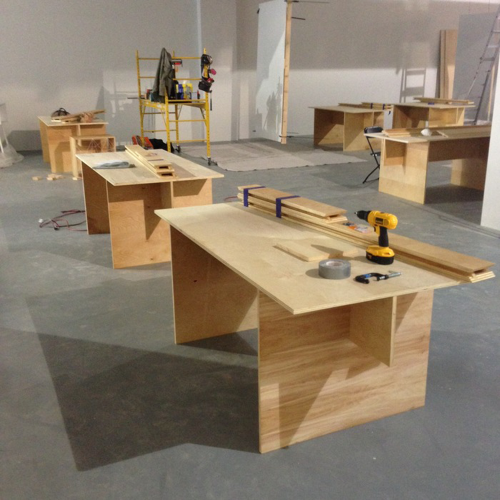
[DA] Rick (Valicenti) and I were talking about the Chicago Design Archive and the subsequent annual Archive competitions. And Rick asked where are they and I said online and he said, no, where ARE THEY?‘ I said the latest actual pieces to the competitions are probably in Bob Zeni’s basement. Maybe you guys are the repository.
[TW] We don’t have the space for it now.
[DA] True, but maybe you can find someone to donate the space and you can be responsible for it’s safe keeping and presenting it every now and then. Where is your ideal permanent space located?
[TW] Here. The West Loop and River North are always future options, but the intention is to be in a space that is very accessible to the public. From a visitor’s point of view, you almost have to leave the Loop to get to the neighborhood culture. It’s a question of audience for us. We have two audiences for the moment. There’s the design community, who we absolutely love. But, we also want to start talking to the general public. We want to brand Chicago outside of Chicago. We’re talking about how to raise Chicago’s influence internationally.
[DA] DesignApplause!
[TW] There you go.
[DA] What’s your arrangement in Block Thirty Seven if I can ask.
[TW] It’s a six-month rolling lease, and we hope to be here as long as possible.
[DA] What’s a good ‘length-of-show’ for you and how many times a year? Can you look at the MCA for example and see how long a show stays up?
[TW] That’s a good, complex question. Some shows can run longer depending on the content, but maybe our goal will become to create shows of equal content if that’s possible.
[DA] The best course is knowing that everybody is different and you learn by doing. Wallpaper magazine is a good example, always trying something. They have a cool concept now called ‘Handmade’ and it debuted in Milan, this is it’s fifth year. 70 pieces and the show just came to ICFF in New York. What’s amazing to me is Wallpape knows they are going to do it but the participants have about two-two 1/2 months to conceive and hang it.
[TW] Yes, exactly, just do it. You know there are many institutions that have done similar things.
[DA] How many people are helping you at the moment.
[TW] At the moment about 35. The institution expands and contracts as needed. We feel fortunate to have such skilled and passionate friends, followers, and volunteers.
[DA] Who’s on your board? Just graphic designers?
[TW] No. Lauren Boegen is our Administrative Director and works at Adler. Jessica Vician is our Marketing Director and works as a content strategist for SPC Educational Solutions. Moving forward, we are trying to build a more traditional board, particularly around development and fundraising.
[DA] What’s next?
[TW] We have a couple of concepts on the table, and will fill you in soon!
[DA] Tanner, let’s close this chat with why you do this and do you get yourself into panic attacks.
[TW] I am in constant panic. Now, I have more time to think. In any design discipline, there is a state of panic, a desire for constant improvement. We’ve learned a lot about timeframes, and are managing the work better with each exhibition. We have a very curious, passionate, creative group who take on a ton of the pressure.
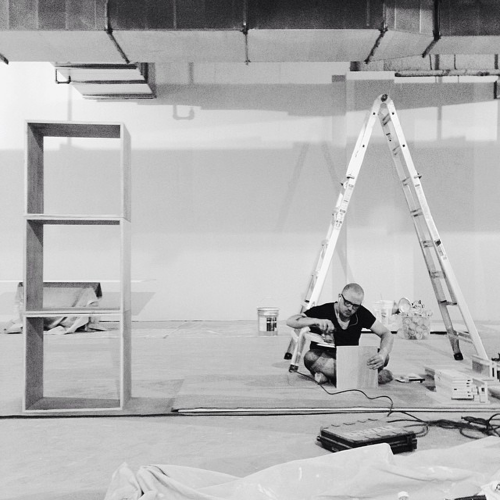 tanner
tanner
[DA] What about you personally. It is as simple as you saying ‘I own this property and what kind of a person would I be if I wasn’t always trying to improve it.’
[TW] That’s an interesting question. I think my personality has been intertwined with museum’s for the last three years, even while I was at Morningstar. I was (and still am) passionate about Morningstar, but there is definitely something about building this business from the ground up. There is this idea to constantly make things better.
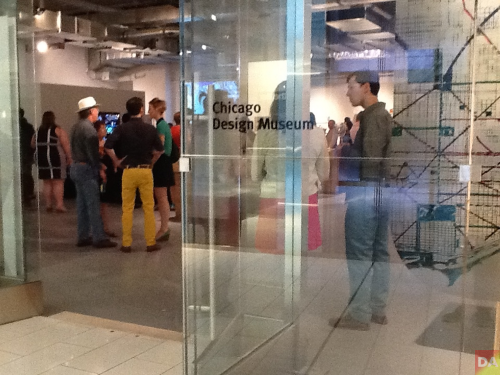 vip opening night
vip opening night
1> plan of chicago | daniel h. burnham | 1908 ( oldest entry in show )
2> 2013 morningstar annual report | morningstar design | 2014 ( most recent entry in show )
3> support board
[ chicago design museum – interview 2012 ]
event> starts/speculations: graphic design in chicago past and future
date> 12 june > 30 august 2014
venue> block thirty seven | 3rd floor | 108 north state street chicago
open to public> tues>sat noon>7p



